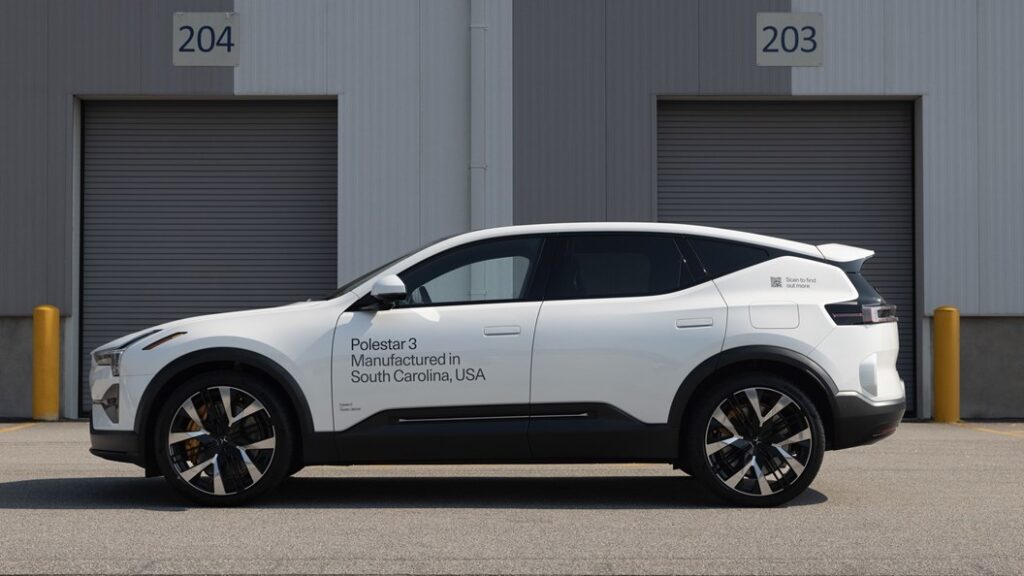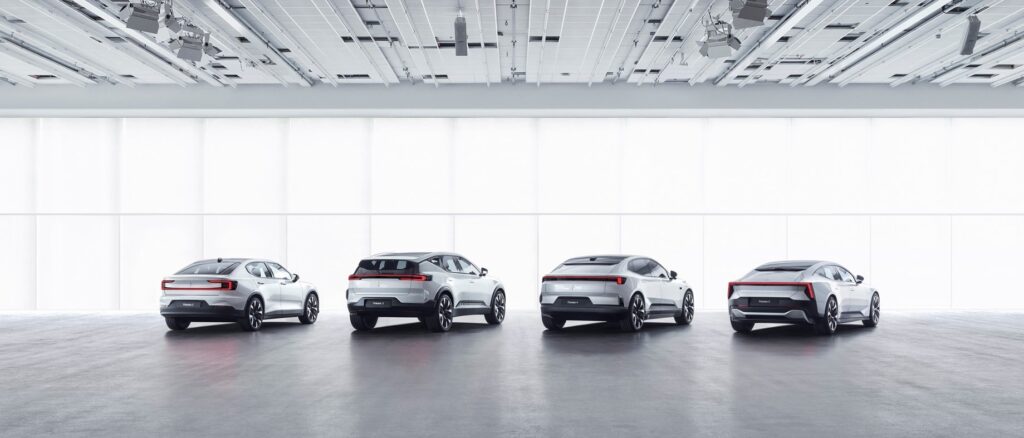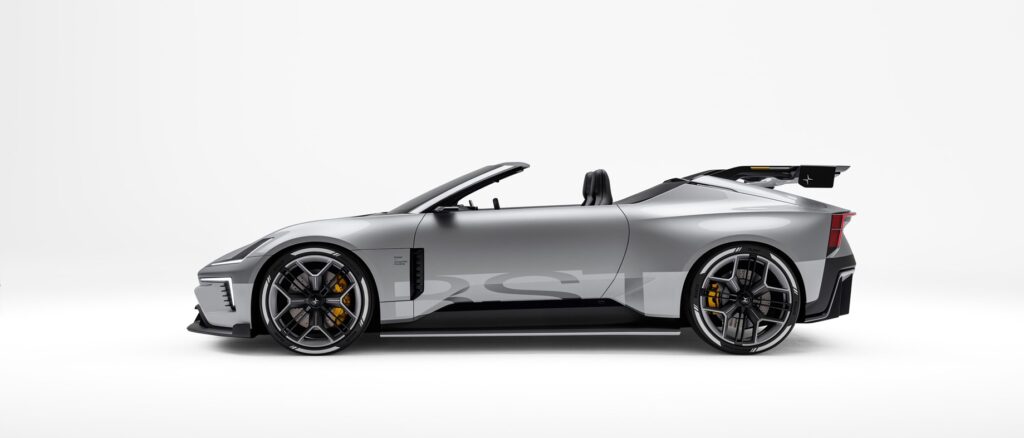Polestar 3 Begins Production in the US, Company Debuts Sporty Concept BST
Polestar, a Swedish electric performance car brand majority-owned by China’s Geely, has been manufacturing its vehicles primarily in China for export to various global markets. However, with the introduction of the Polestar 3, the company has expanded its manufacturing footprint to the United States. The Polestar 3, a premium electric SUV, is being produced at Volvo’s plant in Ridgeville, South Carolina, reflecting Polestar’s commitment to local production for the U.S. market. Volvo is also owned by Geely.
The imposition of steep tariffs by the U.S. and Europe on cars made in China has accelerated the shift in production strategies for many automakers. These tariffs, part of broader trade tensions and economic policies aimed at protecting domestic industries, have made it more costly for companies to export vehicles from China to key markets like the U.S. and Europe. In response, automakers are increasingly moving parts of their production to other countries to avoid these tariffs and potential trade tensions.

This strategic move not only helps Polestar better serve its customers in the U.S. but also aligns with the growing trend of automakers localizing production to mitigate supply chain challenges. Additionally, producing the Polestar 3 in the U.S. could make the vehicle eligible for federal tax incentives under the Inflation Reduction Act, which requires EVs to be assembled in North America to qualify.
The Polestar 3 is also set to be available in European markets, marking it as a global vehicle produced in the U.S. for both domestic and international consumers. This move enhances Polestar’s competitive positioning in the luxury EV segment and supports its ambitions for growth in key markets.

“If you look at the bulk of volume that we will produce of Polestar 3, of course, the majority of that volume will be here coming out of the South Carolina factory,” Chief Executive Thomas Ingenlath said.
Polestar has announced that production at its U.S. plant in South Carolina is expected to reach full volume in two months, though the company has not disclosed the facility’s specific capacity.
Deliveries of the Polestar 3 from this plant are slated to begin next month for U.S. customers, with European deliveries to follow soon after.
The company has already established a presence in the U.S. market with the Polestar 2 sedan, selling 3,555 units in the first half of the year, according to estimates from Kelley Blue Book. This model helped the brand build its reputation in the competitive EV market.
Looking ahead, Polestar plans to manufacture its upcoming Polestar 4 SUV coupes at a Renault Korea plant in South Korea, beginning in mid-2025. This plant is partially owned by Geely, which also owns a majority stake in Polestar. The decision to produce the Polestar 4 in South Korea is likely influenced by the ongoing tariff challenges and the strategic advantage of localizing production closer to key markets. However, until production starts at the South Korean facility, U.S. deliveries of the Polestar 4, which are expected to begin later this year, will be subject to tariffs. This could impact pricing and competitiveness in the U.S. market, potentially making the vehicle less attractive compared to models produced domestically.
Polestar’s strategy to expand production outside of China reflects its efforts to navigate the complex global trade environment while continuing its growth in the U.S. and Europe.

Polestar’s Sales Are Down In Q2 2024
Polestar reported that its global electric car deliveries for the second quarter of 2024 reached approximately 13,000 units. The company highlighted that this result represents an 80% increase compared to the first quarter of 2024, which saw a weaker performance with just 7,221 units delivered.
However, despite the significant quarter-over-quarter improvement, a year-over-year comparison reveals no growth in sales. This indicates that while Polestar experienced a strong rebound in the second quarter, the company’s overall sales performance has remained flat compared to the same period in the previous year. This stagnation could suggest challenges in maintaining momentum or increasing market share in a highly competitive EV market.
Despite expanding its lineup with the introduction of the Polestar 4 and the recent launch of the Polestar 3 in June 2024, Polestar’s overall sales volume has decreased year-over-year. This decline in volume, even with a broader range of models, suggests that the company might be facing challenges in driving growth or gaining traction in the market amidst increasing competition.
Kelley Blue Book’s Electric Vehicle Sales Report, Q2 2024, showed Polestar had an electric vehicle brand segment share of 2.2% in Q2 and .06% year-to-date.
Polestar Concept BST Debut
At the Goodwood Festival of Speed on July 11, 2024, Polestar showcased the Polestar Concept BST, making its global debut. The event marked the dynamic debut of this electric roadster concept, capturing the attention of motoring enthusiasts at the renowned festival.
Thomas Ingenlath, CEO of Polestar said: “Now we are a brand with three models in production, it’s great to see them here together for the first time at a global event. Goodwood Festival of Speed is full of the most exciting cars and the most enthusiastic crowds, so it’s the perfect place for us to tease our Polestar Concept BST. This car is a demonstration of how far we can push our performance brand – Polestar turned up to 11, if you will – and a demonstration of how we could apply the BST formula to our line-up in the future.”
The Polestar Concept BST features bespoke bodywork in a classic motorsport silver, complemented by muscular flared arches, an extra-wide track, and 22-inch forged alloy wheels. Its aerodynamically optimized bonnet with a unique vented design is paired with an aggressive front splitter and an extreme rear wing. The design is completed with racing-livery inspired graphics, emphasizing its motorsport theme.

Polestar’s Cash Flow, Job Cuts, Extreme Fast Charging, Projected Future
The company said that its staff reductions of 450 jobs globally announced in January 2024 were completed, resulting in 15% fewer positions, in addition to its 10% reduction in 2023.
Ingenlath spoke about the company’s cash flow. Ingenlath said Polestar will focus on reducing the cost of materials and logistics, and increase efficiency to cut costs in order to increase cash flow to break even in 2025. Ingenlath looked to Polestar’s future with optimism.
Ingenlath said: “We have strong momentum as we enter the second half of the year. Our two new SUV’s have received stellar reviews from the global media and first test drive slots were booked out and additional slots are filling up fast. Our retail sales model shift is accelerating in Europe and we have strengthened our sales management team.”
“We expect strong revenue improvement in the second quarter and are confident about our business performance in the latter part of the year. Looking further ahead, our model expansion and increased market presence – with seven new market launches to come in 2025 – will be key growth drivers for us,” Ingenlath continued.
EVinfo.net believes Polestar could be an EV leader. The main problem we are seeing is that the luxury EV market in the US is saturated, so its difficult for any luxury EV to gain traction. Polestar makes a very high quality product, so that’s not the problem why its not selling more, its the high price. Hopefully its sister company, Volvo, will make a low-cost EV for the American market. The low-cost segment remains wide open as of the date of this writing, August 19, 2024. The first company to bring low cost EVs to America will win big. In the world of internal combustion engine (ICE) vehicles, this was exactly how Toyota, Honda, and other Japanese OEMs made tremendous profits in the US market.
In April 2024, Polestar made a major breakthrough with a successful demonstration of its extreme fast charging capabilities. Using special battery cells provided by StoreDot, a team of Polestar R&D battery specialists charged a prototype Polestar 5 battery pack from 10 to 80 percent in exactly 10 minutes. EVinfo.net gives this as an example of how EV technology is moving fast, with lower charging times and higher range capabilities every year. This will hasten the demise of gas-burning, polluting internal combustion engine (ICE) vehicles, as EVs move to mass adoption in the US and around the globe very soon.

Electric Vehicle Marketing Consultant, Writer and Editor. Publisher EVinfo.net.
Services